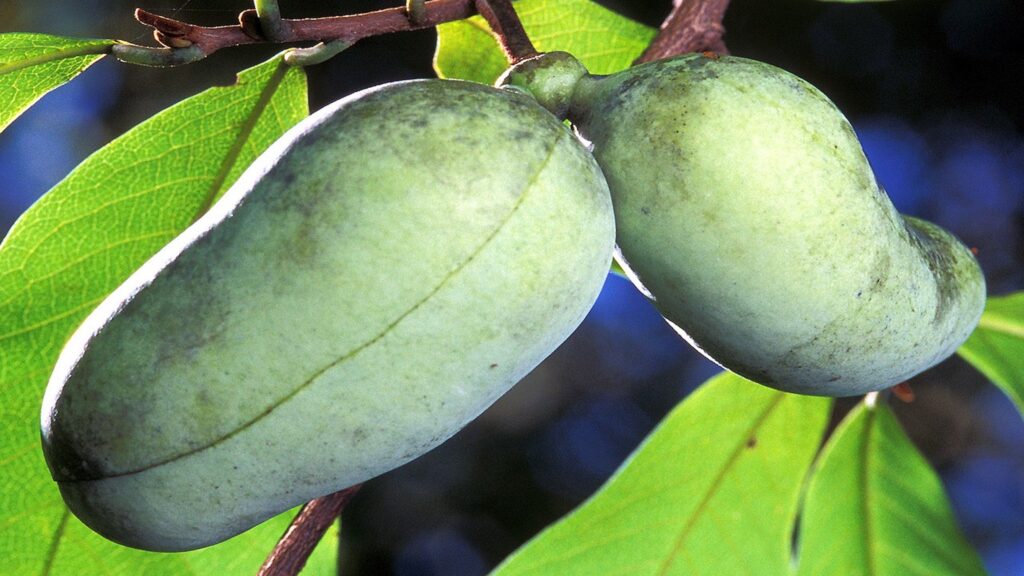
The pawpaw tree, which bears the largest fruit native to North America, may bear new fruit for scientists seeking ways to fight cancer.
Purdue University researcher Jerry McLaughlin, working with doctoral student Nicholas Oberlies, has found compounds in the bark of the tree that have shown preliminary success in fighting some drug- resistant cancers.
The studies show that the pawpaw compounds not only are effective in killing tumors that have proven resistant to anti-cancer agents, but also seem to have a special affinity for such resistant cells.
McLaughlin will talk on the anticancer properties of the pawpaw compound Thursday, Sept. 11 at the American Chemical Society national meeting in Las Vegas. The findings also were published this summer in the journal Cancer Letters and the Journal of Medicinal Chemistry.
Though further studies are needed to pinpoint exactly how the pawpaw compounds work within the cancer cell, McLaughlin says their effect is to pull the plug on the energy-producing mechanisms in the cell.
McLaughlin notes, however, that the effect on drug-resistant cells has been studied only in laboratory cultures and will require additional study in animals before it can be tested in humans.
“Multidrug-resistant cancer is hard to treat because the cancer cell has developed a mechanism to get around the anti-cancer agent,” says McLaughlin, professor of pharmacognosy in Purdue’s School of Pharmacy and Pharmacal Science. “Tumor cells that survive chemotherapy treatments often recover with increased resistance to the agent used in the original treatment program as well as to other related drugs.”
Such resistance can develop when surviving cancer cells develop one or more mechanisms to accelerate the removal of noxious substances, including anti-cancer drugs. One of the most common mechanisms used to circumvent the anti-cancer agents is to develop a “pump” that is capable of pushing anti-cancer agents out of the cell before they can kill it. These pumps are called P-glycoprotein mediated pumps and are named for the type of protein used to construct and operate them.
Though all cells have the ability to develop such a pump, normal cells seldom do. Even in cancer cells, which do not respond normally to the body’s control mechanisms, only a small percentage of cells develop this pumping mechanism.
“If having this pump was such a good deal, all cells would have it. But all cells don’t,” McLaughlin says. “In a given population of cancer cells in a person, maybe only 2 percent of the cancer cells possess this pump. But it’s those 2 percent of cancer cells that eventually grow and expand to create drug-resistant tumors.”
One of the tricks currently attempted in treating cancer patients is to flood the body with other compounds to keep the pump busy, and then administer high doses of an anti-cancer agent in hopes that some of it will be able to stay in long enough to kill the cancer cell.
“But the high doses of the drugs required for this treatment often produce side effects, such as loss of blood pressure, so the patient often succumbs to the side effects of the treatment,” McLaughlin says.
Though this pump mechanism is efficient at eliminating most anti- cancer agents, McLaughlin, whose research group has identified more than 40 pawpaw compounds with anti-cancer properties, discovered a series of the compounds, called Annonaceous acetogenins, that were capable of killing cancer cells that employed this mechanism.
He then designed a laboratory study to analyze the cytotoxic or cell- killing effects of one of the compounds, called bullatacin, on human mammary cancer cells. The study compared bullatacin’s effects on standard, nonresistant cancer cells and on multidrug-resistant cells.
In the June issue of Cancer Letters, the research team reported that bullatacin preferentially killed the multidrug-resistant cells by inhibiting the production of adenosine triphosphate, or ATP. ATP is a compound that works to release energy in a cell and is essential to all cell processes.
“A multidrug-resistant cell requires a tremendous amount of energy to run the pump and extrude things out of the cell,” McLaughlin says. “By inhibiting ATP production, we’re essentially pulling the plug on its energy source.”
Though the pawpaw compounds also inhibited ATP production in noncancerous cells and nonresistant cancer cells, those cells were not affected as dramatically, McLaughlin says.
“Normal cells and standard cancer cells may be able to minimize the effects of this compound because they don’t require the vast amounts of energy needed by the pump-running cells,” McLaughlin says. “The resistant cell is using its extra energy for this pump as well as to grow, so it is really taxed for energy. When we mess with the energy supply, it kills the cell.”
McLaughlin and his group then did a follow-up study to test a series of 14 structurally similar pawpaw compounds to determine the structural features that maximize this biological activity in multidrug- resistant cancer cells. The results were published in the June issue of the Journal of Medicinal Chemistry.
“This study tells us how to maximize this activity, so we have a pretty good idea what compounds we’d like to try in animals with multidrug-resistant tumors,” McLaughlin says.
If proven effective in animals and humans, McLaughlin says, the compounds may be used to treat multi-drug resistance in a variety of cancers, because many types of cancer cells develop resistance by employing a pump.
 A daily dose of yogurt could be the go-to food to manage high blood pressure
A daily dose of yogurt could be the go-to food to manage high blood pressure WHO advises not to use non-sugar sweeteners for weight control
WHO advises not to use non-sugar sweeteners for weight control Most U.S. children use potentially toxic makeup products, often during play
Most U.S. children use potentially toxic makeup products, often during play To Block The Carcinogens, Add A Touch Of Rosemary When Grilling Meats
To Block The Carcinogens, Add A Touch Of Rosemary When Grilling Meats